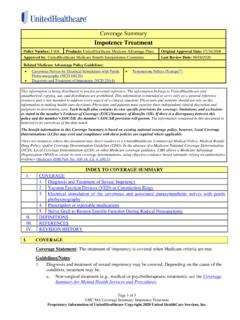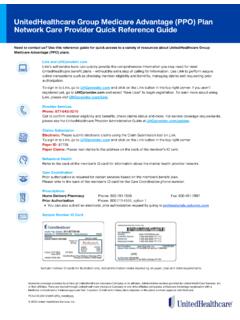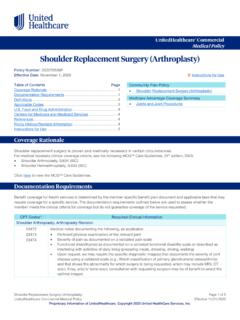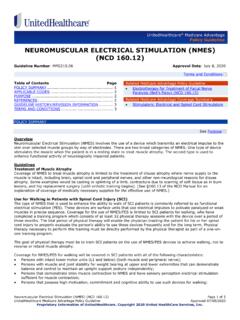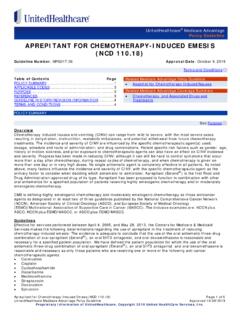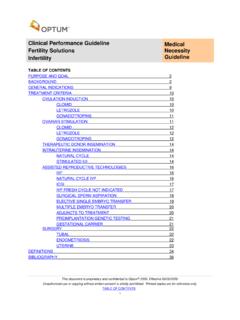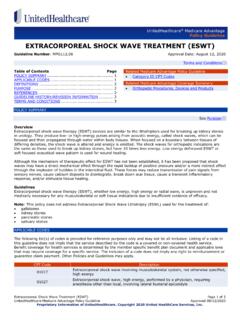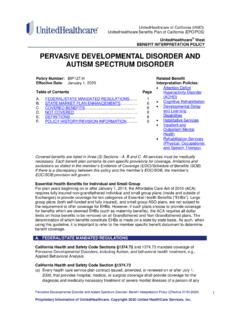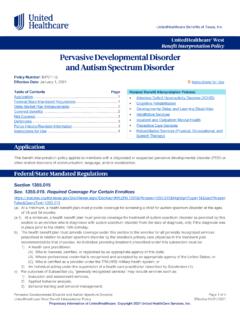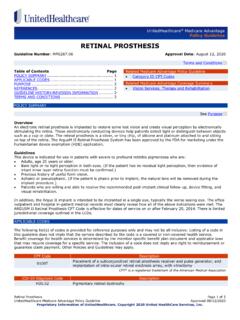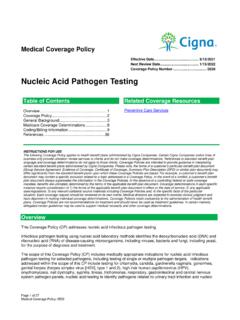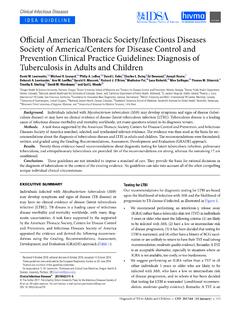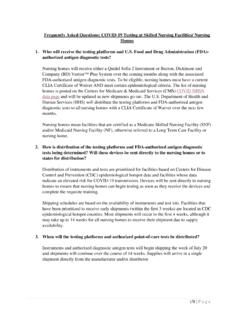Transcription of Genitourinary Pathogen Detection Panel Testing
1 UnitedHealthcare Commercial Medical Policy Genitourinary Pathogen Nucleic Acid Detection Panel Testing Policy Number: 2021T0608D. Effective Date: April 1, 2021 Instructions for Use Table of Contents Page Community Plan Policy Coverage Rationale .. 1 Genitourinary Pathogen Nucleic Acid Detection Definitions .. 1 Panel Testing Applicable Codes .. 2. Description of Services .. 2. Clinical Evidence .. 3. Food and Drug Administration .. 8. References .. 8. Policy History/Revision Information .. 10. Instructions for Use .. 10. Coverage Rationale The following are proven and medically necessary to evaluate symptomatic women for Vaginitis: Direct and amplified DNA probe Testing for Trichomoniasis vaginalis Direct probe Testing for Candida sp Due to insufficient evidence of efficacy, the following are unproven and not medically necessary: Amplified DNA probe Testing for vulvovaginitis due to Candida sp Direct and amplified DNA probe Testing for bacterial Vaginosis ( , Gardnerella vaginalis).
2 Multiplex polymerase chain reaction (PCR) Panel Testing of Genitourinary pathogens, including but not limited to pathogens commonly associated with Vaginitis Note: This policy does not apply to tests for gonorrhea and chlamydia. Definitions Sexually Transmitted Infection (STI): An STI is an infection that is spread by sexual contact. Infections include chlamydia, gonorrhea, human papillomavirus (HPV), herpes, syphilis, and human immunodeficiency virus (HIV) (American College of Obstetricians and Gynecologists, 2019). Vaginitis: Vaginitis is defined as inflammation or infection of the vagina. The most common causes of Vaginitis include vulvovaginal candidiasis, trichomoniasis, and bacterial Vaginosis (American College of Obstetricians and Gynecologists, 2020). Vaginosis: Vaginosis is caused by the overgrowth of a number of organisms that are normally found in the vagina.
3 It is a common cause of Vaginitis (American College of Obstetricians and Gynecologists, 2020). Genitourinary Pathogen Nucleic Acid Detection Panel Testing Page 1 of 11. UnitedHealthcare Commercial Medical Policy Effective 04/01/2021. Proprietary Information of UnitedHealthcare. Copyright 2021 United HealthCare Services, Inc. Applicable Codes The following list(s) of procedure and/or diagnosis codes is provided for reference purposes only and may not be all inclusive. Listing of a code in this policy does not imply that the service described by the code is a covered or non-covered health service. Benefit coverage for health services is determined by the member specific benefit plan document and applicable laws that may require coverage for a specific service. The inclusion of a code does not imply any right to reimbursement or guarantee claim payment.
4 Other Policies and Guidelines may apply. CPT Code Description 0068U Candida species Panel (C. albicans, C. glabrata, C. parapsilosis, C. kruseii, C tropicalis, and C. auris), amplified probe technique with qualitative report of the presence or absence of each species 81513 infectious disease , bacterial vaginosis, quantitative real-time amplification of RNA markers for Atopobium vaginae, Gardnerella vaginalis, and Lactobacillus species, utilizing vaginal-fluid specimens, algorithm reported as a positive or negative result for bacterial vaginosis 81514 infectious disease , bacterial vaginosis and vaginitis, quantitative real-time amplification of DNA markers for Gardnerella vaginalis, Atopobium vaginae, Megasphaera type 1, Bacterial Vaginosis Associated Bacteria-2 (BVAB-2), and Lactobacillus species (L. crispatus and L. jensenii), utilizing vaginal-fluid specimens, algorithm reported as a positive or negative for high likelihood of bacterial vaginosis, includes separate Detection of Trichomonas vaginalis and/or Candida species (C.)
5 Albicans, C. tropicalis, C. parapsilosis, C. dubliniensis), Candida glabrata, Candida krusei, when reported 87480 infectious agent Detection by nucleic acid (DNA or RNA); Candida species, direct probe technique 87481 infectious agent Detection by nucleic acid (DNA or RNA); Candida species, amplified probe technique 87482 infectious agent Detection by nucleic acid (DNA or RNA); Candida species, quantification 87510 infectious agent Detection by nucleic acid (DNA or RNA); Gardnerella vaginalis, direct probe technique 87511 infectious agent Detection by nucleic acid (DNA or RNA); Gardnerella vaginalis, amplified probe technique 87512 infectious agent Detection by nucleic acid (DNA or RNA); Gardnerella vaginalis, quantification 87660 infectious agent Detection by nucleic acid (DNA or RNA); Trichomonas vaginalis, direct probe technique 87661 infectious agent Detection by nucleic acid (DNA or RNA); Trichomonas vaginalis, amplified probe technique 87797 infectious agent Detection by nucleic acid (DNA or RNA), not otherwise specified; direct probe technique, each organism 87798 infectious agent Detection by nucleic acid (DNA or RNA), not otherwise specified; amplified probe technique, each organism 87799 infectious agent Detection by nucleic acid (DNA or RNA), not otherwise specified; quantification, each organism 87800 infectious agent Detection by nucleic acid (DNA or RNA), multiple organisms; direct probe(s) technique 87801 infectious agent Detection by nucleic acid (DNA or RNA), multiple organisms; amplified probe(s).
6 Technique CPT is a registered trademark of the American Medical Association Description of Services Bacterial Vaginosis (BV), Trichomonas vaginalis (T. vaginalis) and Candida species cause the highest number of cases of acute vulvovaginal symptoms that lead a woman to seek medical care. The physician must assimilate information from the history and physical examination with information obtained from a vaginal swab to make a diagnosis for the appropriate treatment. Material from the swab can be used to make a determination of vaginal pH, to prepare slides for microscopy, to perform molecular tests and other rapid tests, and to culture organisms. molecular Testing for diagnosis of vaginal infection is based on the Detection of one or more specific nucleic acid sequences. In Genitourinary Pathogen Nucleic Acid Detection Panel Testing Page 2 of 11.
7 UnitedHealthcare Commercial Medical Policy Effective 04/01/2021. Proprietary Information of UnitedHealthcare. Copyright 2021 United HealthCare Services, Inc. the United States, most molecular assays currently available for Vaginitis/Vaginosis are direct DNA probe tests and nucleic acid amplification tests (Coleman and Gaydos, 2018). The potential use of nucleic acid probe technology for the diagnosis of Vaginitis/Vaginosis was explored in the mid-1990s with the development of a DNA probe assay. Several manufacturers have now developed nucleic acid amplification tests (NAAT). and Panel assays using Polymerase Chain Reaction (PCR) which can detect multiple pathogens. For example, Affirm VPIII, a commercially available DNA probe test, utilizes hybridization of specific organismal sequences to specific labeled DNA probes to detect Candida species, Gardnerella vaginalis (as a marker for BV), and T.
8 Vaginalis. Clinical Evidence Common Causes of Vaginitis The most common causes of vaginitis include trichomoniasis, bacterial vaginosis (BV), and vulvovaginal candidiasis (VVC). Table 1 describes the main features of these three causes. Table 1. Features of Vaginitis/Vaginosis Infection Discharge Whiff test pH Microscopy Candida species Thick Negative Normal (< ) Yeasts, hyphae Bacterial vaginosis Thin, homogeneous Positive Increased (> ) Clue cells, decreased Lactobacilli Trichomonas vaginalis Frothy, yellow-green Positive Increased (> ) Protozoa Diagnosis of vaginitis/vaginosis typically hinges on the proper evaluation of a significant amount of data, including the information presented in the table above, and can be quite time-consuming. Despite the frequency with which women present to their doctors with complaints of vaginal symptoms, physicians do not always reliably carry out the diagnostic protocol (Schwiertz et al.)
9 , 2006). Correct, timely identification of pathogens is critical for treatment, prevention of the spread of contagious disease , and reduction in the risks associated with vaginal infection. Bacterial Vaginosis (BV). BV is the most common documented cause of vulvovaginitis among women of reproductive age. In the United States, the prevalence of BV in the general population is estimated to be almost one in three women (Allsworth and Peipert, 2007). BV can produce vaginal discharge and a fishy odor, but the majority of women are asymptomatic (Koumans et al., 2007). BV is a polymicrobial infection that is characterized by a shift in vaginal microbiota from an acidic pH (< ) with Lactobacillus species to a more alkaline pH heralded by the presence of Gardnerella vaginalis, a gram-variable coccobacillus, and marked by the presence of other species including Prevotella, Mobiluncus, Ureaplasma and Mycoplasma (Jones, 2019).
10 BV is of significant public health interest, not just because of its high prevalence, but because it is associated with an increased risk of other medical complications including preterm labor and pelvic inflammatory disease along with increased risk to acquire sexually transmitted infections (Paavonen and Brunham, 2018). Despite its association with adverse pregnancy outcomes, the United States Preventive Services Task Force does not currently recommend screening of asymptomatic pregnant women for bacterial vaginosis although workup of symptomatic women is recommended (USPSTF, 2008). BV can be successfully treated with antibiotics, though the recurrence rate is high. BV can be sexually transmitted and is one of the most commonly diagnosed infections in women following sexual assault. Treatment of sexual partners does not decrease the recurrence rate (CDC, 2015).
